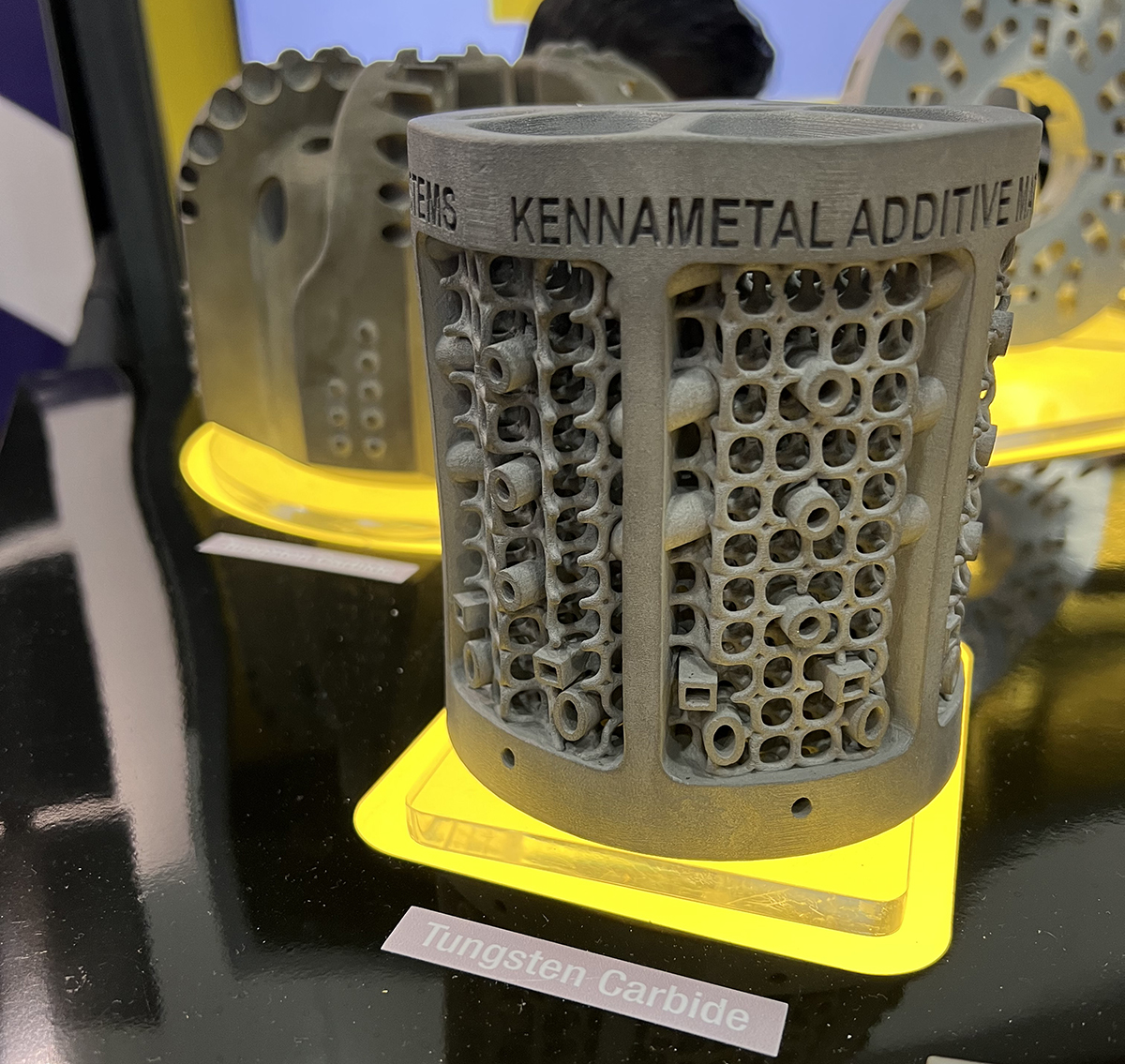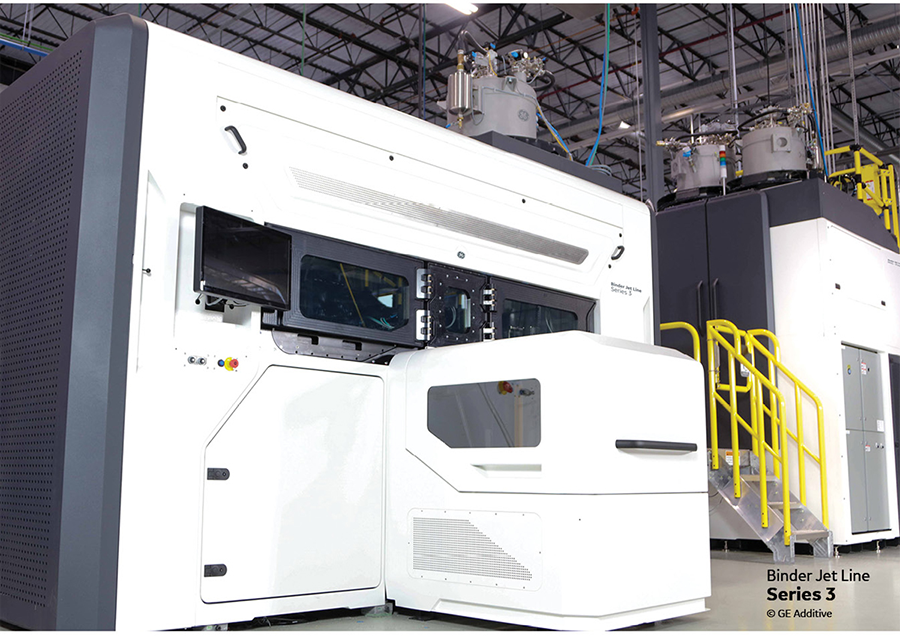Kennametal recently announced it has joined GE Additive’s Beta Partner Program, focusing on advancing its binder jetting capabilities in cemented tungsten carbide—and expanding the range of possibilities for use of the technology across such industries as oil and gas and mining. To learn more while at RAPID+TCT 2022, 3DPrint.com was on the ground with the combined GE Additive and Kennametal teams, including Brian Birkmeyer, Product Line Leader for Binder Jet at GE Additive, as well as Jay Verellen, General Manager of Additive Manufacturing at the Kennametal Infrastructure Business Group.
With the latest news as a jumping off point, we learned some interesting details about both Kennametal’s additive operations, as well as GE’s metal binder jetting program.
Kennametal Advances in Metal Binder Jetting
Verellen explained that what drives the company’s decision making is the needs of its customers. If a client has a specific need, Kennametal will apply its materials science expertise, particularly in tungsten carbide and cobalt-chromium (branded as Stellite), to address that need. Primarily, this means subtractive and formative manufacturing of these materials, but, with the establishment of Kennametal’s additive division in 2019, the company has increasingly been leveraging their innovation in 3D printing. This has resulted in thousands of Kennametal 3D printed parts already in the field and running. The firm turned to GE Additive to help advance and scale its existing binder jetting capabilities.

A 3D printed tungsten carbide part demonstrating the complexity and weight reduction possible for an extremely heavy metal.
For over a year, Kennametal and GE Additive collaborated on the technology. This began with the Kennametal team working with GE at its own facility. Once sufficiently developed, A GE metal binder jetting system for tungsten carbide was delivered to Kennametal’s own site for use in development and production.
In order to produce tungsten carbide parts, the company 3D prints tungsten carbide with a cobalt binder, resulting in a fully dense part. The percentage of cobalt can be varied depending on customer needs, including 17 percent and 13 percent varieties. The less cobalt there is in a formula, the greater the wear resistance. The tougher variety also includes ingredients that increase corrosion resistance, such as nickel and other materials. KAR85 is Kennametal’s most corrosion- and wear-resistant solution for truly next-level performance.
Kennametal is able to offer its customers what Verellen referred to as a “end-to-end component solutions,” meaning everything from the design to the finishing of the part:
“We’ve been alongside our customers for subtractive and formative manufacturing already for quite some time. Now, we’re applying our longstanding materials and manufacturing expertise to leverage the advantages of additive and deliver performance and value for customers. It’s more than a novelty. We’re regularly using AM to solve customer challenges whether that’s a downhole oil and gas component on a short lead time or a flow control device with complex design features.”
Of course, there are pre-manufacturing design considerations to be made for 3D printing tungsten carbide components, but there’s also in process and post-process considerations to be made. This includes sintering and taking into account the shrinkage that will occur. For this particular issue, GE has a homegrown software solution called Amp, released at Formnext 2021, which has been modified for use with binder jetting.
GE’s Series 3 Metal Binder Jet 3D Printer
While talking to the team, first and foremost on my mind was the commercial release of the binder jetting platform, the third generation of which was teased during the Kennametal announcement. I quickly learned that, while the technology is still being rolled out in a beta program, it is essentially on the market already.
A company as large as GE isn’t necessarily selling its binder jetting machines to every interested party. Instead, it is performing a strategic roll-out with key customers in different verticals: Cummins for power generation and automotive, Wabtec for rail, Sandvik for mining, and Kennametal for industrial applications when wear and corrosion resistance are critical.
“The key for us across our beta partner network is different folks with different end applications and, in many cases, different materials. What’s really nice [working with Kennametal] is that we are able to add another company with great material expertise in a new material for use on our platform. The beta partner network has helped us focus on customers who really want to bring the technologies production—companies who really want to drive that application space forward and actually have an eye for taking a component or a material into scale production,” Birkmeyer said. “Some have said that we’re being secretive, which we’re not. We’ve always said we’re not in any rush to launch the machine.”
With that in mind, the GE team acknowledged that they couldn’t give an exact date for the general release of the machine, except to say that it was “coming soon,” alluding to an announcement sometime this year. However, Cummins is commercializing an engine component made with the technology. So, though we have yet to see an industry-wide roll-out of the platform, we may already be feeling its effects.
Subscribe to Our Email Newsletter
Stay up-to-date on all the latest news from the 3D printing industry and receive information and offers from third party vendors.
You May Also Like
High Stakes, High Speed: KVG Acquires 15 Nexa3D HSE 3D Printers to Boost Military Tech
As 3D printing increasingly intersects with defense and military logistics, a new partnership between Nexa3D and mission support logistics firm KVG stresses the growing importance of this technology in strategic...
3D Printer Maker EVO-tech Reborn as NEVO3D — Once More With Feeling
EVO-tech was a 3D printing service and original equipment manufacturer established in 2013 and based in Schörfling am Attersee, Austria. The company produced high-quality material extrusion systems featuring linear bearings,...
3D Printing News Briefs, March 16, 2024: Partnerships, Affordable Bioprinter, & More
We’re starting with dental 3D printing news today, and then moving on to some new partnerships. Then it’s on to some interesting university research about 3D printing plant-based pharmaceuticals, but...
FDR vs. SLA: The Right Polymer Manufacturing Choice for Your Application
The additive manufacturing (AM) industry has no shortage of acronyms when it comes to the various methodologies of industrial 3D printing. In polymer 3D printing, there are three main methods...

































